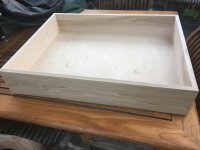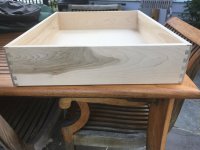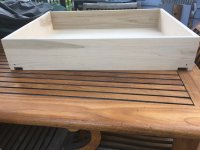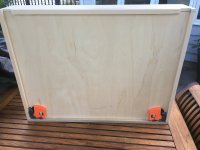1st- Welcome to the FOG!
I'm not sure if I'm reading too deep into your post, but I'm guessing you are budget conscious, or at least your budget is not unlimited. Therefore, I'm keeping that in mind with my recommendations.
First, a little background: I worked for a cabinet company for 11 years- I left there 20 years ago but I still dream of some of the equipment we had there, but obviously a different world of tools in a production environment. I now build furniture as a part-time business, but I remember the cabinet construction methods quite well so I wanted to build all the cabinets for our new home we built 2 years ago, and did so in my old shop. Here are the primary tools used with comments:
-TS55- used this to breakdown all the sheet goods. First started with two rails connected, but even after carefully setting up with a straight edge, I would sometimes get out of square cuts within the 8' length, so I got the long rail- problem solved. I was then able to get more precise cuts with the plywood using the track saw than if I would use the table saw. Cross-cuts were done using the MFT- I went a long time thinking I didn't need an MFT, but worked wonderfully during my cabinet build. I have used my TS55 for deck builds as well, although I hear the HK55 or HKC55 work much better for this application.
-Cabinet Saw- used to rip hardwood (red oak) for face frame stiles/rails, drawer fronts, etc. Much easier to cut 1-1/2" stiles/rails on a table saw than anything else IMHO. As mentioned in an earlier post- safety first! Use push sticks or get a set of the GRR-RIPPERs. The only hardwood I cut with the TS55 was the hardwood edge banding used on the cabinet shelves, but that was with the help of parallel guides- you can cut the edge banding on the table saw too. With some extension tables, you can get by with a portable saw instead of cabinet saw- many on the FOG have had good luck with a Dewalt model. Get a good dado blade and use the table saw for end panel dadoes.
- Kreg Jig- used this for assembly of all face frames. Great jig- makes this task easy. Tip: this jig is a pain without dust collection- make sure to use the hood that comes with the jig and hook up to a vac. Also, use a comfortable cordless drill- your wrist will thank you after all the pocket holes and screws.
- LR32 with OF 1010 router- makes shelf pins a breeze. Yes, it seems expensive for what you get, but pin holes are spot-on accurate and, when you think of all the pin holes for adjustable shelving in a kitchen, 4 bathrooms, and a bar, I cannot imagine the time savings as well.
- CT Vac- an absolute must for me (I no longer sneeze constantly in the shop). It's not only a health thing for me- not as much sawdust to clean up at the end of the day.
-Miter saw- even though the MFT is great for cross-cutting wider pieces such as end panels and shelves, a miter saw works best for face frame parts and the like. I have the Kapex that I purchased a few years ago, but there are many other miter saws that are less expensive that can do this operation for cabinets, too, and get great results. If you cannot spring for a miter saw, build a table saw sled. It won't be quite as efficient, but will get the job done and safely.
-Sanders- sanding is my least favorite operation but I understand it is also one of the most important. I used to use other brands of sanders, but once I purchased my first Festool sander, I switched everything over. If you can only afford a couple sanders, the two I recommend for cabinets are ETS-150/3 and RS-2E, then buy the rest of the Festool line when you can afford them. If you can spring for a third one, I'd recommend ETS-125 (or latest version) 5" model- much easier to use on face frames and smaller parts/edging. And don't forget to use a Syslite to spot defects that need sanding. Or, better yet, the new inspection light to be released in a month looks to be a great option too.
There are other power tools that will make life easier as well (domino, oscillating spindle sander, etc) but already have quite a list above. Hand tools? Good square, accurate tape measure, sharp chisels, dead blow hammer are all must-haves- don't over-look them. Best of luck with your purchases and upcoming builds- lots of fun ahead of you!
Regards,
Gerald




